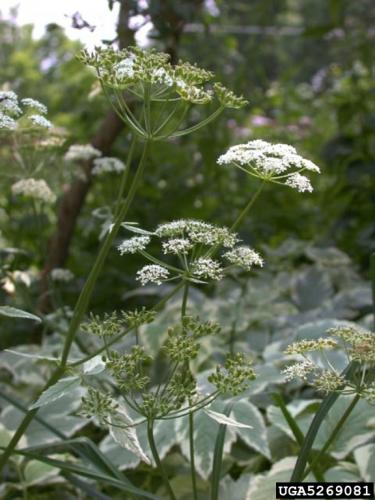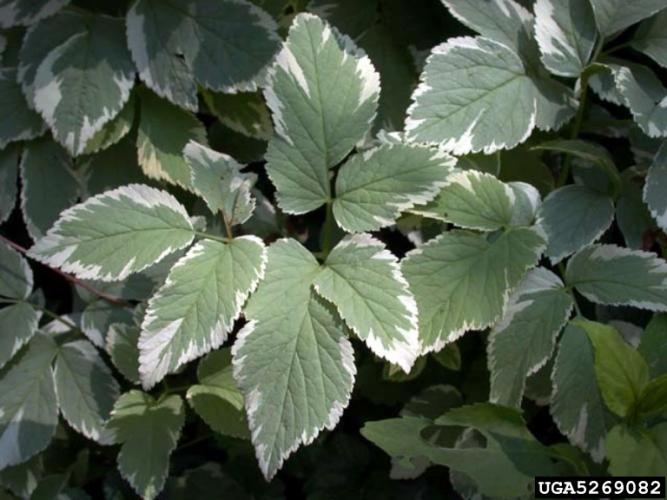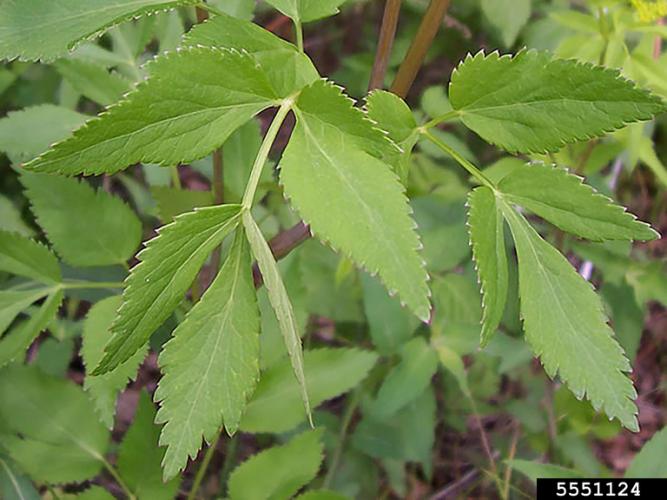Goutweed or Bishop's Weed
Identification
Appearance
Aegopodium podagraria is a creeping, herbaceous perennial that can grow to be 15-40 inches tall.
Foliage
The basal and lower leaves have long petioles. There are usually 9 leaflets per lower leaf, although this can vary. Each leaflet is ovate with an acute or acuminate apex. The bases of these leaflets can be rounded or cordate. The lower leaflets are 1-3 inches long and have a serrate margin. The upper leaflets are similar to the lower leaflets, but are smaller and ternate in their arrangement, and have shorter petioles. A commonly planted form has variegated leaves, bluish-green color leaves with creamy white edges.
Flowers
The white flowers are arranged in umbels that are 2.25-4.75 inches in diameter. Each umbel is borne on a long peduncle, and has 15-25 rays that are about 1 inch or more in length. The flowers of Aegopodium podagraria appear in June.
Fruit
The brown fruits oblong-ovoid, laterally flattened and 0.12-0.16 inches long.
***check out the downloadable fact sheet above***
Biology
Ecological Threat
Goutweed is aggressive, forming dense, impenetrable patches that displace native plants and greatly reduce ground-layer species diversity. Its colonies also inhibit the establishment of native tree seedlings. Highly shade tolerant, it is capable of invading closed-canopy forests.
Origin
Goutweed was brought to North America as an ornamental by early European settlers. By 1863, it was well established in the United States. It is utilized as a low maintenance ground cover.
Habitat
Forest, forest edge, riverbank, streambank, meadows, fields, disturbed areas
Life Cycle
Goutweed is an aggressive perennial that reproduces primarily vegetatively through a rhizome system. Seeds require cold stratification to germinate, and the seed bank is short-lived. Seeds usually will germinate the next year after initial dispersal. New foliage appears in early spring and flowers bloom in June with small white umbels. The seeds turn brown when they ripen in late summer.
Vermont Distribution
How You Can Help
NATIVE/NON-INVASIVE ALTERNATIVES
Golden alexanders (Zizia aurea), Canadian anemone (Anemone canadensis), Wild sarsaparilla (Aralia nudicaulis)
Native Perennials and Shrubs for Vermont Gardens
Alternatives to Common Invasive Plants and Characteristics of Select Alternatives
Citations
PHOTO CREDIT
Varigated leaves and leaf arrangement, 5269082, Leslie J. Mehrhoff, University of Connecticut
Goutweed infestation, 5446517, Leslie J. Mehrhoff, UNiveristy of Connecticut
Goutweed flower, 5269081, Leslie J. Mehrhoff, University of Connecticut
Golden Alexander leaves (LAL), 5551124, Katy Chayka, minnasotawildflowers.info, CC Non-com 3.0
INFORMATION CREDIT
Vermont Chapter of The Nature Conservancy



